Silver, Its Salts and Application in Medicine and Pharmacy
Abstract
1. Introduction
2. Silver and Its Salts
3. Application of Silver and Silver (I) Salts in Medicine
- DEFINITION:
- Colloidal, metallic silver containing protein.
- Content: from 70.0% to 80.0% Ag (calculated on the dried substance).
- PROPERTIES:
- Appearance: green or bluish-black, metallic flakes or powder, hygroscopic.
- Solubility: easily soluble or soluble in water, practically insoluble in ethanol (96%) and in methylene chloride.
A substance with a bactericidal and astringent effect, both for oral and external application. It is used in catarrh of the conjunctiva and mucous membranes; in gonorrhea. Internally in gastric and duodenal ulcers. Externally in the form of solutions, ointments 0.5–4%. Internally, a 1–2% solution should be administered in tablespoons.
4. Silver (I) Complexes
- Rp.
- Argenti nitrici 1.0
- Metronidazoli 2.0
- Aquae destillatae q.s.
- Eucerini S ad 100.0
- M.f.Ung. D.S. externally 2 times a day
5. Conclusions
Author Contributions
Funding
Institutional Review Board Statement
Informed Consent Statement
Data Availability Statement
Acknowledgments
Conflicts of Interest
References
- Charkhian, H.; Bodaqlouie, A.; Soleimannezhadbari, E.; Lotfollahi, L.; Shaykh-Baygloo, N.; Hosseinzadeh, R.; Yousefi, N.; Khodayar, M. Comparing the Bacteriostatic Effects of Different Metal Nanoparticles Against Proteus vulgaris. Curr. Microbiol. 2020, 77, 2674–2684. [Google Scholar] [CrossRef] [PubMed]
- Da Silva Martins, L.H.; Rai, M.; Neto, J.M.; Gomes, P.W.P.; da Silva Martins, J.H. Silver: Biomedical Applications and Adverse Effects. In Biomedical Applications of Metals; Springer: Cham, Switzerland, 2018; pp. 113–127. [Google Scholar]
- Frei, A. Metal Complexes, an Untapped Source of Antibiotic Potential? Antibiotics 2020, 9, 90. [Google Scholar] [CrossRef] [PubMed]
- Kosmider, B.; Zyner, E.; Osiecka, R.; Ochocki, J. Genotoxicity of cis-Pt(II) complex of 3-aminoflavone in comparison with cis_DDP in A549 cells evaluated by comet assay. Can. J. Physiol. Pharmacol. 2004, 82, 353–358. [Google Scholar] [CrossRef] [PubMed]
- Ciesielska, E.; Szulawska, A.; Studzian, K.; Ochocki, J.; Malinowska, K.; Kik, K.; Szmigiero, L. Comparative studies on the mechanism of cytotoxic action of novel platinum II complexes with pyrazole ligadns. J. Inorg. Biochem. 2006, 100, 1579–1585. [Google Scholar] [CrossRef] [PubMed]
- Kontek, R.; Matlawska-Wasowska, K.; Kalinowska-Lis, U.; Kontek, B.; Ochocki, J. Evaluation of cytotoxity of new trans-palladium(II) complex in human cells in vitro. Acta Pol. Pharm. 2011, 68, 127–136. [Google Scholar] [PubMed]
- Kasprzak, M.; Fabijanska, M.; Checinska, L.; Studzian, K.; Markowicz-Piasecka, M.; Sikora, J.; Mikiciuk-Olasik, E.; Ochocki, J. Small differences in structure, large difference in activity-Comparison of the new Ru (II) -3-hydroxyiminoflavanone complex with analogous Ru (II) compounds. Inorg. Chim. Acta 2017, 457, 69–80. [Google Scholar] [CrossRef]
- Antonarakis, E.S.; Emadi, A. Ruthenium-based chemotherapeutics: Are they ready for prime time? Cancer Chemother. Pharmacol. 2010, 66, 1–9. [Google Scholar] [CrossRef] [PubMed]
- Morais, T.S.; Valente, A.; Tomaz, A.I.; Marques, F.; Garcia, M.H. Tracking antitumor metallodrugs: Promising agents with the Ru(II)- and Fe(II)-cyclopentadienyl scaffolds. Future Med. Chem. 2016, 8, 527–544. [Google Scholar] [CrossRef]
- Emsley, J. Chemistry. Chemical Elements Guide; Scientific Publishing PWN: Warsaw, Poland, 1997. [Google Scholar]
- Daintith, J. (Ed.) A Concise Dictionary of Chemistry; Oxford University Press: Oxford, UK, 1991. [Google Scholar]
- Malinowski, P.; Derzsi, M.; Mazej, Z.; Jagličić, Z.; Gaweł, B.; Łasocha, W.; Grochala, W. AgIISO4: A Genuine Sulfate of Divalent Silver with Anomalously Strong One-Dimensional Antiferromagnetic Interactions. Angew. Chem. Int. Ed. 2010, 49, 1683–1686. [Google Scholar] [CrossRef]
- Saltlakemetals.com. Available online: https://saltlakemetals.com/solubility_of_silver_compounds/ (accessed on 19 March 2023).
- Department of Pharmacopoeia. Polish Pharmacopoeia, 11th ed.; Office for Registration of Medicinal Products, Medical Devises and Biocidal Products: Warszawa, Poland, 2017.
- WHO. The International Pharmacopoeia, 11th ed.; WHO: Geneva, Switzerland, 2022. Available online: https://digicollections.net/phint/2022/index.html#d/b.6.2.1.3 (accessed on 19 March 2023).
- Balazs, D.J.; Triandafillu, K.; Wood, P.; Chevolot, Y.; van Delden, C.; Harms, H.; Hollenstein, C.; Mathieu, H.J. Inhibition of bacterial adhesion on PVC endotracheal tubes by RF-oxygen glow discharge, sodium hydroxide and silver nitrate treatments. Biomaterials 2004, 25, 2139–2151. [Google Scholar] [CrossRef]
- Alexander, J.W. History of the medical use of silver. Surg. Infect. 2009, 10, 289–292. [Google Scholar] [CrossRef] [PubMed]
- Department of Pharmacopoeia. Polish Pharmacopoeia, 12th ed.; Office for Registration of Medicinal Products, Medical Devises and Biocidal Products: Warszawa, Poland, 2020.
- Li, Y.; Qin, T.; Ingle, T.; Yan, J.; He, W.; Yin, J.J.; Chen, T. Differential genotoxicity mechanisms of silver nanoparticles and silver ions. Arch. Toxicol. 2017, 91, 509–519. [Google Scholar] [CrossRef] [PubMed]
- Radko, L.; Stypuła-Trębas, S.; Posyniak, A.; Żyro, D.; Ochocki, J. Silver(I) Complexes of the Pharmaceutical Agents Metronidazole and 4-Hydroxymethylpyridine: Comparison of Cytotoxic Profile for Potential Clinical Application. Molecules 2019, 24, 1949. [Google Scholar] [CrossRef] [PubMed]
- Pharmacopoeia of Poland II; with the consent of the Society of Friends of Pharmaceutical Faculties and Branches at Universities in Poland; Pharmaceutical Publishing Institute of the Chief Pharmaceutical Chamber Named after Prof. Bronisław Kojkowski: Warsaw, Poland, 1946.
- Muszyński, J. (Ed.) Polish Pharmacopoeia III; PZWL: Warszawa, Poland, 1954. [Google Scholar]
- The Japanese Pharmacopoeia, 17th ed.; English Version; The Ministry of Health, Labour and Welfare: Tokyo, Japan, 2016; Available online: https://www.mhlw.go.jp/file/06-Seisakujouhou-11120000-Iyakushokuhinkyoku/JP17_REV_1.pdf (accessed on 19 March 2023).
- Bober, S.; Gobiec, K.; Kempisty, J.; Konieczny, Z.; Podlewski, J.; Wellenger, A. Therapeutic Guide to USL; PZWL: Warsaw, Poland, 1959. [Google Scholar]
- Rosenman, K.D.; Moss, A.; Kon, S. Argyria: Clinical implications of exposure to silver nitrate and silver oxide. J. Occup. Environ. Med. 1979, 21, 430–435. [Google Scholar]
- Hill, W.R.; Pillsbury, D.M. Argyria-The Pharmacology of Silver; Williams & Wilkins: Baltimore, MD, USA, 1939. [Google Scholar]
- Rollings, N.B. Georgia Arbuckle Fix: Silver dollar surgeon. Am. Hist. Illus. 1985, 20, 20–21. [Google Scholar]
- Moore, D.L.; MacDonald, N.E. Canadian Paediatric Society, Infectious Diseases and Immunization Committee. Preventing ophthalmia neonatorum. Paediatr. Child Health 2015, 20, 93–96. [Google Scholar] [PubMed]
- Silva, L.R.; Gurgel, R.Q.; Lima, D.R.; Cuevas, L.E. Current usefulness of Credé’s method of preventing neonatal ophthalmia. Ann. Trop. Paediatr. 2008, 28, 45–48. [Google Scholar] [CrossRef] [PubMed]
- Roe, A.L. Collosol argentum and its ophthalmic uses. Br. Med. J. 1915, 16, 104. [Google Scholar] [CrossRef][Green Version]
- Bernd, N.; Krug, H.F.; Height, M. 120 years of nanosilver history: Implications for policy makers. Environ. Sci. Technol. 2011, 45, 1177–1183. [Google Scholar]
- Shcherbakov, A.B.; Kortschak, H.Y.; Surmasheva, E.W.; Skorokhod, Y.M. Silver preparations: Yesterday, today, tomorrow. Pharm. J. 2006, 5, 45–57. [Google Scholar]
- Rodionov, P.P.; Tretyakov, V.V. Collargol and Protargol. Properties. Colloidal Silver. Physicochemical Characteristics. Application in Medicine; G. K. Boreskova Institute of Catalysis: Novosibirsk, Russia, 1992; pp. 1–14. [Google Scholar]
- Kostyleva, R.N.; Burmistrov, V.A.; Polunina, O.A. Comparative study of the bactericidal activity of colloidal silver preparations. In Proceedings of the 462 Silver and Bismuth in Medicine: Materials of Scientific–Practical Conference, Novosibirsk, Russia, 25–26 February 2005; p. 312. [Google Scholar]
- Polova, Ż.M. Study of the antimicrobial activity of silver and copper citrates for the purpose of developing pharmaceutical preparations. Curr. Issues Pharm. Med. Sci. Pract. 2016, 1, 71–74. [Google Scholar]
- Kaplan, A.; Akalin Ciftci, G.; Kutlu, H.M. Cytotoxic, anti-proliferative and apoptotic effects of silver nitrate against H-ras transformed 5RP7. Cytotechnology 2016, 68, 1727–1735. [Google Scholar] [CrossRef] [PubMed]
- Sahin-Bolukbasi, S.; Sahin, N.; Tahir, M.N.; Arici, C.; Cevik, E.; Gurbuz, N.; Cummings, B.S. Novel N-heterocyclic carbine silver(I) complexes: Synthesis, structural characterization, and anticancer activity. Inorg. Chim. Acta 2018, 486, 711–718. [Google Scholar] [CrossRef]
- Medici, S.; Peana, M.; Crisponi, G.; Nurchi, V.M.; Lachowicz, J.I.; Remelli, M.; Zoroddu, M.A. Silver coordination compounds: A new horizon in medicine. Coord. Chem. Rev. 2016, 327, 349–359. [Google Scholar] [CrossRef]
- Medici, S.; Peana, M.; Nurchi, V.M.; Zoroddu, M.A. Medical Uses of Silver: History, Myths, and Scientific Evidence. J. Med. Chem. 2019, 62, 5923–5943. [Google Scholar] [CrossRef] [PubMed]
- Kalinowska-Lis, U.; Felczak, A.; Chęcińska, L.; Zawadzka, K.; Patyna, E.; Lisowska, K.; Ochocki, J. Synthesis, characterization and antimicrobial activity of water-soluble silver(I) complexes of metronidazole drug and selected counter-ions. Dalton Trans. 2015, 44, 8178–8189. [Google Scholar] [CrossRef] [PubMed]
- Kalinowska-Lis, U.; Szewczyk, E.M.; Chęcińska, L.; Wojciechowski, J.M.; Wolf, W.M.; Ochocki, J. Synthesis, characterization, and antimicrobial activity of silver(I) and copper(II) complexes of phosphate derivatives of pyridine and benzimidazole. Chem. Med. Chem. 2014, 9, 169–176. [Google Scholar] [CrossRef] [PubMed]
- Kalinowska-Lis, U.; Felczak, A.; Chęcińska, L.; Szabłowska-Gadomska, I.; Patyna, E.; Małecki, M.; Lisowska, K.; Ochocki, J. Antibacterial Activity and Cytotoxicity of Silver(I) Complexes of Pyridine and (Benz)Imidazole Derivatives. X-ray Crystal Structure of [Ag(2,6-di(CH2OH)py)2]NO3. Molecules 2016, 28, 87. [Google Scholar] [CrossRef]
- Ochocki, J.; Kalinowska-Lis, U. EP 2848608B1, Silver Complex Compounds, Method for Their Production and Their Use. European Patent Specification. Bulletin 2017/51. Available online: https://register.epo.org/application?number=EP14174623 (accessed on 19 March 2023).
- Kalinowska-Lis, U.; Felczak, A.; Chęcińska, L.; Lisowska, K.; Ochocki, J. Synthesis, characterization and antimicrobial activity of silver(I) complexes of hydroxymethyl derivatives of pyridine and benzimidazole. J. Organomet. Chem. 2014, 749, 394–399. [Google Scholar] [CrossRef]
- Chernousova, S.; Epple, M. Silver as Antibacterial Agent: Ion, Nanoparticle, and Metal. Angew. Chem. Int. Ed. 2012, 52, 1636–1653. [Google Scholar] [CrossRef]
- Kalishwaralal, K.; BarathManiKanth, S.; Pandian, S.R.K.; Deepak, V.; Gurunathan, S. Silver nano-A trove for retinal therapies. J. Control. Release 2010, 145, 76–90. [Google Scholar] [CrossRef]
- Hardes, J.; Von Eiff, C.; Streitbuerger, A.; Balke, M.; Budny, T.; Henrichs, M.P.; Hauschild, G.; Ahrens, H. Reduction of periprosthetic infection with silver-coated mega-prostheses in patients with bone sarcoma. J. Surg. Oncol. 2010, 101, 389–395. [Google Scholar] [CrossRef] [PubMed]
- Butany, J.; Leask, R.L.; Desai, N.D.; Jegatheeswaran, A.; Silversides, C.; Scully, H.E.; Feindel, C. Pathologic analysis of 19 heart valves with silver-coated sewing rings. J. Cardiovasc. Surg. 2006, 21, 530–538. [Google Scholar] [CrossRef] [PubMed]
- Rodrigues, T.S.; Zhao, M.; Yang, T.H.; Gilroy, K.D.; da Silva, A.G.M.; Camargo, P.H.C.; Xia, Y. Synthesis of Colloidal Metal Nanocrystals: A Comprehensive Review on the Reductants. Chemistry 2019, 25, 11791. [Google Scholar] [CrossRef] [PubMed]
- Tortella, G.R.; Rubilar, O.; Durán, N.; Diez, M.C.; Martínez, M.; Parada, J.; Seabra, A.B. Silver nanoparticles: Toxicity in model organisms as an overview of its hazard for human health and the environment. J. Hazard. Mater. 2020, 390, 121974. [Google Scholar] [CrossRef] [PubMed]
- Gurunathan, S.; Han, J.W.; Kwon, D.N.; Kim, J.H. Enhanced antibacterial and anti-biofilm activities of silver nanoparticles against Gram-negative and Gram-positive bacteria. Nanoscale Res. Lett. 2014, 9, 373. [Google Scholar] [CrossRef] [PubMed]
- Jha, A.K.; Prasad, K.; Prasad, K.; Kulkarni, A.R. Plant system: Nature’s nanofactory. Colloids Surf. B Biointerfaces 2009, 73, 219–223. [Google Scholar] [CrossRef] [PubMed]
- Reina, G.; Peng, S.; Jacquemin, L.; Andrade, A.F.; Bianco, A. Hard Nanomaterials in Time of Viral Pandemics. ACS Nano 2020, 14, 9364–9388. [Google Scholar] [CrossRef] [PubMed]
- El-Samad, L.M.; Bakr, N.R.; El-Ashram, D.; Radwan, E.H.; Abdul Aziz, K.K.; Hussein, H.K.; El Wakil, A.; Hassan, M.A. Silver nanoparticles instigate physiological, genotoxicity, and ultrastructural anomalies in midgut tissues of beetles. Chem.-Biol. Interact. 2022, 367, 110166. [Google Scholar] [CrossRef]
- Akter, M.; Sikder, M.T.; Mostafizur Rahman, M.; Atique Ullah, A.K.M.; Binte Hossain, K.F.; Banik, S.; Hosokawa, T.; Saito, T.; Kurasaki, M. A systematic review on silver nanoparticles-induced cytotoxicity: Physicochemical properties and perspectives. J. Adv. Res. 2018, 9, 1–16. [Google Scholar] [CrossRef]
- Sondi, I.; Salopek-Sondi, B. Silver nanoparticles as antimicrobial agent: A case study on E. coli as a model for Gram-Negat. Bacteria. J. Colloid Interface Sci. 2004, 275, 177–182. [Google Scholar] [CrossRef]
- Kim, J.S.; Kuk, E.; Yu, K.N.; Kim, J.H.; Park, S.J.; Lee, H.J.; Kim, S.H.; Park, Y.K.; Park, Y.H.; Hwang, C.Y.; et al. Antimicrobial effects of silver nanoparticles. Nanomedicine 2007, 3, 95–101. [Google Scholar] [CrossRef] [PubMed]
- Rai, M.K.; Deshmukh, S.D.; Ingle, A.P.; Gade, A.K. Silver nanoparticles: The powerful nanoweapon against multidrug-resistant bacteria. J. Appl. Microbiol. 2012, 112, 841–852. [Google Scholar] [CrossRef] [PubMed]
- Gaikwad, S.; Ingle, A.; Gade, A.; Rai, M.; Falanga, A.; Incoronato, N.; Russo, L.; Galdiero, S.; Galdiero, M. Antiviral activity of mycosynthesized silver nanoparticles against herpes simplex virus and human parainfluenza virus type 3. Int. J. Nanomed. 2013, 8, 4303–4314. [Google Scholar]
- Sivasankarapillai, V.S.; Pillai, A.M.; Rahdar, A.; Sobha, A.P.; Das, S.S.; Mitropoulos, A.C.; Mokarrar, M.H.; Kyzas, G.Z. On Facing the SARS-CoV-2 (COVID-19) with Combination of Nanomaterials and Medicine: Possible Strategies and First Challenges. Nanomaterials 2020, 10, 852. [Google Scholar] [CrossRef]
- Li, Y.; Lin, Z.; Zhao, M.; Xu, T.; Wang, C.; Hua, L.; Wang, H.; Xia, H.; Zhu, B. Silver Nanoparticle Based Codelivery of Oseltamivir to Inhibit the Activity of the H1N1 Influenza Virus through ROS-Mediated Signaling Pathways. ACS Appl. Mater. Interfaces 2016, 8, 24385–24393. [Google Scholar] [CrossRef] [PubMed]
- Lee, Y.-T.; Ko, E.-J.; Hwang, H.S.; Lee, J.S.; Kim, K.-H.; Kwon, Y.-M.; Kang, S.-M. Respiratory syncytial virus-like nanoparticle vaccination induces long-term protection without pulmonary disease by modulating cytokines and T-cells partially through alveolar macrophages. Int. J. Nanomed. 2015, 10, 4491–4505. [Google Scholar]
- Nadworny, P.L.; Wang, J.; Tredget, E.E.; Burrell, R.E. Anti-inflammatory activity of nanocrystalline silver in a porcine contact dermatitis model. Nanomedicine 2008, 4, 241–251. [Google Scholar] [CrossRef] [PubMed]
- Bhol, K.C.; Schechter, P.J. Topical nanocrystalline silver cream suppresses inflammatory cytokines and induces apoptosis of inflammatory cells in a murine model of allergic contact dermatitis. Br. J. Dermatol. 2005, 152, 1235–1242. [Google Scholar] [CrossRef]
- Bhol, K.C.; Schechter, P.J. Effects of nanocrystalline silver (NPI 32101) in a rat model of ulcerative colitis. Dig. Dis. Sci. 2007, 52, 2732–2742. [Google Scholar] [CrossRef]
- Modak, S.M.; Sampath, L.; Fox, C.L.J. Combined topical use of silver sulfadiazine and antibiotics as a possible solution to bacterial resistance in burn wounds. J. Burn Care Rehabil. 1988, 9, 359–363. [Google Scholar] [CrossRef] [PubMed]
- FlorCruz, N.V.; Evans, J.R. Medical interventions for fungal keratitis. Cochrane Database Syst. Rev. 2015, 9, CD004241. [Google Scholar] [CrossRef] [PubMed]
- Mohan, M.; Gupta, S.K.; Kalra, V.K.; Vajpayee, R.B.; Sachdev, M.S. Topical silver sulphadiazine-A new drug for ocular keratomycosis. Br. J. Ophthalmol. 1988, 72, 192–195. [Google Scholar] [CrossRef] [PubMed]
- Trzaska, S. Cisplatin. Chem. Eng. News 2005, 83, 52. [Google Scholar] [CrossRef]
- Carpenter, D.P. Reputation and Power: Organizational Image and Pharmaceutical Regulation at the FDA; Princeton University Press: Princeton, NJ, USA, 2010; ISBN 978-0-691-14180-0. [Google Scholar]
- Approval Summary for Cisplatin for Metastatic Ovarian Tumors. FDA Oncology Tools. Food and Drug Administration, Center for Drug Evaluation and Research. 1978. Available online: https://web.archive.org/web/20080208232952/http://www.accessdata.fda.gov/scripts/cder/onctools/summary.cfm?ID=73 (accessed on 19 March 2023).
- Wiltshaw, E. Cisplatin in the treatment of cancer. Platin. Met. Rev. 1979, 23, 90–98. [Google Scholar]
- Drasch, G.; Gath, H.J.; Heissler, E.; Schupp, I.; Roider, G. Silver Concentrations in Human Tissues. Their Dependence on Dental Amalgam and Other Factors. Trace Elem. Med. Biol. 1995, 9, 82–87. [Google Scholar] [CrossRef] [PubMed]
- Goyer, R.A.; Clarkson, T.W.; Klaassen, C.D. (Eds.) Casarett & Doull’s Toxicology. The Basic Science of Poisons, 5th ed.; McGraw-Hill Health Professions Division: New York, NY, USA, 1996; ISBN 71054766. [Google Scholar]
- Hadrup, N.; Lam, H.R. Oral toxicity of silver ions, silver nanoparticles and colloidal silver-a review. Regul. Toxicol. Pharmacol. 2014, 68, 1–7. [Google Scholar] [CrossRef] [PubMed]
- Lencastre, A.; Lobo, M.; João, A. Argyria-Case report. An. Bras. Dermatol. 2013, 88, 413–416. [Google Scholar] [CrossRef]
- Thati, B.; Noble, A.; Creaven, B.S.; Walsh, M.; McCann, M.; Kavanagh, K.; Devereux, M.; Egan, D.A. In vitro anti-tumour and cyto-selective effects of coumarin-3-carboxylic acid and three of its hydroxylated derivatives, along with their silver-based complexes, using human epithelial carcinoma cell lines. Cancer Lett. 2007, 248, 321–331. [Google Scholar] [CrossRef]
- Zhu, H.L.; Zhang, X.-M.; Liu, X.Y.; Wang, X.J.; Liu, G.F.; Usman, A.; Fun, H.K. Clear Ag–Ag bonds in three silver(I) carboxylate complexes with high cytotoxicity properties. Inorg. Chem. Commun. 2003, 6, 1113–1116. [Google Scholar] [CrossRef]
- Liu, J.J.; Galettis, P.; Farr, A.; Maharaj, L.; Samarasinha, H.; McGechan, A.C.; Baguley, B.C.; Bowen, R.J.; Berners-Price, S.J.; McKeage, M.J. In vitro antitumour and hepatotoxicity profiles of Au(I) and Ag(I) bidentate pyridyl phosphine complexes and relationships to cellular uptake. J. Inorg. Biochem. 2008, 102, 303–310. [Google Scholar] [CrossRef]
- Hindi, K.M.; Panzner, M.J.; Tessier, C.A.; Cannon, C.L.; Youngs, W.J. The medicinal applications of imidazolium carbene-metal complexes. Chem. Rev. 2009, 109, 3859–3884. [Google Scholar] [CrossRef] [PubMed]
- Teyssot, M.L.; Jarrousse, A.S.; Manin, M.; Chevry, A.; Roche, S.; Norre, F.; Beaudoin, C.; Morel, L.; Boyer, D.; Mahiou, R.; et al. Metal-NHC complexes: A survey of anti-cancer properties. Dalton Trans. 2009, 35, 6894–6902. [Google Scholar] [CrossRef] [PubMed]
- Rubbiani, R.; Kitanovic, I.; Alborzinia, H.; Can, S.; Kitanovic, A.; Onambele, L.A.; Stefanopoulou, M.; Geldmacher, Y.; Sheldrick, W.S.; Wolber, G.; et al. Benzimidazol-2-ylidene Gold(I) Complexes Are Thioredoxin Reductase Inhibitors with Multiple Antitumor Properties. J. Med. Chem. 2010, 53, 8608–8618. [Google Scholar] [CrossRef] [PubMed]
- Banti, C.N.; Hadjikakou, S.K. Anti-proliferative and anti-tumor activity of silver(I) compounds. Metallomics 2013, 5, 569–596. [Google Scholar] [CrossRef] [PubMed]
- Liu, X.Y.; Zhu, H.L. Strong silver-silver interactions in three silver(I) carboxylate complexes with high cytotoxicity properties. Synth. React. Inorg. Met. Org. Nano Met. Chem. 2005, 35, 325–332. [Google Scholar] [CrossRef]
- Żyro, D.; Śliwińska, A.; Szymczak-Pajor, I.; Stręk, M.; Ochocki, J. Light Stability, Pro-Apoptotic and Genotoxic Properties of Silver (I) Complexes of Metronidazole and 4-Hydroxymethylpyridine against Pancreatic Cancer Cells In Vitro. Cancers 2020, 12, 3848. [Google Scholar] [CrossRef] [PubMed]
- Żyro, D.; Radko, L.; Śliwińska, A.; Chęcińska, L.; Kusz, J.; Korona-Głowniak, I.; Przekora, A.; Wójcik, M.; Posyniak, A.; Ochocki, J. Multifunctional Silver(I) Complexes with Metronidazole Drug Reveal Antimicrobial Properties and Antitumor Activity against Human Hepatoma and Colorectal Adenocarcinoma Cells. Cancers 2022, 14, 900. [Google Scholar] [CrossRef]
- Starek, M.; Dąbrowska, M.; Chebda, J.; Żyro, D.; Ochocki, J. Stability of Metronidazole and Its Complexes with Silver(I) Salts under Various Stress Conditions. Molecules 2021, 26, 3582. [Google Scholar] [CrossRef]
- Medici, S.; Peana, M.; Nurchi, V.M.; Lachowicz, J.I.; Crisponi, G.; Zoroddu, M.A. Noble metals in medicine: Latest advances. Coord. Chem. Rev. 2015, 284, 329–350. [Google Scholar] [CrossRef]
- Massoud, A.A.; Langer, V.; Gohar, Y.M.; Abu-Youssef, M.A.M.; Jänis, J.; Lindberg, G.; Hansson, K.; Öhrström, L. Effects of different substituents on the crystal structures and antimicrobial activities of six Ag(I) quinoline compounds. Inorg. Chem. 2013, 52, 4046–4060. [Google Scholar] [CrossRef] [PubMed][Green Version]
- Ortego, L.; Meireles, M.; Kasper, C.; Laguna, A.; Villacampa, M.D.; Gimeno, M.C. Group 11 complexes with amino acid derivatives: Synthesis and antitumoral studies. J. Inorg. Biochem. 2016, 156, 133–144. [Google Scholar] [CrossRef] [PubMed]
- Drugs.com. Available online: https://www.drugs.com/monograph/sulfadiazine.html (accessed on 19 March 2023).
- Stuart, M.C.; Kouimtzi, M.; Hill, S.R. (Eds.) WHO Model Formulary; World Health Organization: Geneva, Switzerland, 2008; Volume 126, p. 205. ISBN 9789241547659.
- Baenzinger, N.C.; Struss, A.W. Crystal structure of 2-sulfanilamidopyrimidinesilver(I). Inorg. Chem. 1976, 15, 1807–1809. [Google Scholar] [CrossRef]
- Waszczykowska, A.; Żyro, D.; Jurowski, P.; Ochocki, J. Effect of treatment with silver(I) complex of metronidazole on ocular rosacea: Design and formulation of new silver drug with potent antimicrobial activity. J. Trace Elem. Med. Biol. 2020, 61, 126531. [Google Scholar] [CrossRef] [PubMed]
- Żyro, D. Formulations of Drug Forms Containing the MTZ Complex with Silver (I) Nitrate. Unpublished. Doctoral Dissertation, Medical University of Lodz, Lodz, Poland, 2021. [Google Scholar]
- Candido, T.Z.; de Paiva, R.E.F.; Figueiredo, M.C.; de Oliveira Coser, L.; Frajácomo, S.C.L.; Abbehausen, C.; Cardinalli, I.A.; Lustri, W.R.; Carvalho, J.E.; Ruiz, A.L.T.G.; et al. Silver Nimesulide Complex in Bacterial Cellulose Membranes as an Innovative Therapeutic Method for Topical Treatment of Skin Squamous Cell Carcinoma. Pharmaceutics 2022, 14, 462. [Google Scholar] [CrossRef] [PubMed]
- Sun, M.C.; Chen, Y.F.; Liu, D.; Xu, X.L.; You, Y.C.; Lu, W.; Shi, Y.J.; Ren, M.Y.; Fan, Y.B.; Du, Y.Z.; et al. Effective decolonization strategy for mupirocin-resistant Staphylococcus aureus by TPGS-modified mupirocin-silver complex. Mater. Today Bio 2023, 18, 100534. [Google Scholar] [CrossRef] [PubMed]
- Rao, B.R.; Kumar, R.; Haque, S.; Kumar, J.M.; Rao, T.N.; Kothapalli, R.V.S.N.; Patra, C.R. Ag2[Fe(CN)5NO]-Fabricated Hydrophobic Cotton as a Potential Wound Healing Dressing: An In Vivo Approach. ACS Appl. Mater. Interfaces 2021, 13, 10689–10704. [Google Scholar] [CrossRef]
- Sharma, T.; Kumar, R.; Sahoo, S.C.; Sindhu, J.; Singh, J.; Singh, B.; Mehta, S.K.; Umar, A.; Saini, T.S.; Kumar, V.; et al. Synthesis, structural and pharmacological exploration of 2-(3, 5-dimethyl-1H-pyrazol-1-yl)-acetophenone oximes and their silver complexes. Polyhedron 2021, 195, 114972. [Google Scholar] [CrossRef]
- Roberts, K.E.; Engelbrecht, Z.; Potgieter, K.; Meijboom, R.; Cronjé, M.J. Silver(I) Bromide Phosphines Induce Mitochondrial-Mediated Apoptosis in Malignant Human Colorectal Cells. Biomedicines 2023, 11, 2794. [Google Scholar] [CrossRef]
- Rendošová, M.; Gyepes, R.; Maruščáková, I.C.; Mudroňová, D.; Sabolová, D.; Kello, M.; Vilková, M.; Almáši, M.; Huntošová, V.; Zemek, O.; et al. An in vitro selective inhibitory effect of silver(I) aminoacidates against bacteria and intestinal cell lines and elucidation of the mechanism of action by means of DNA binding properties, DNA cleavage and cell cycle arrest. Dalton Trans. 2021, 50, 936–953. [Google Scholar] [CrossRef]
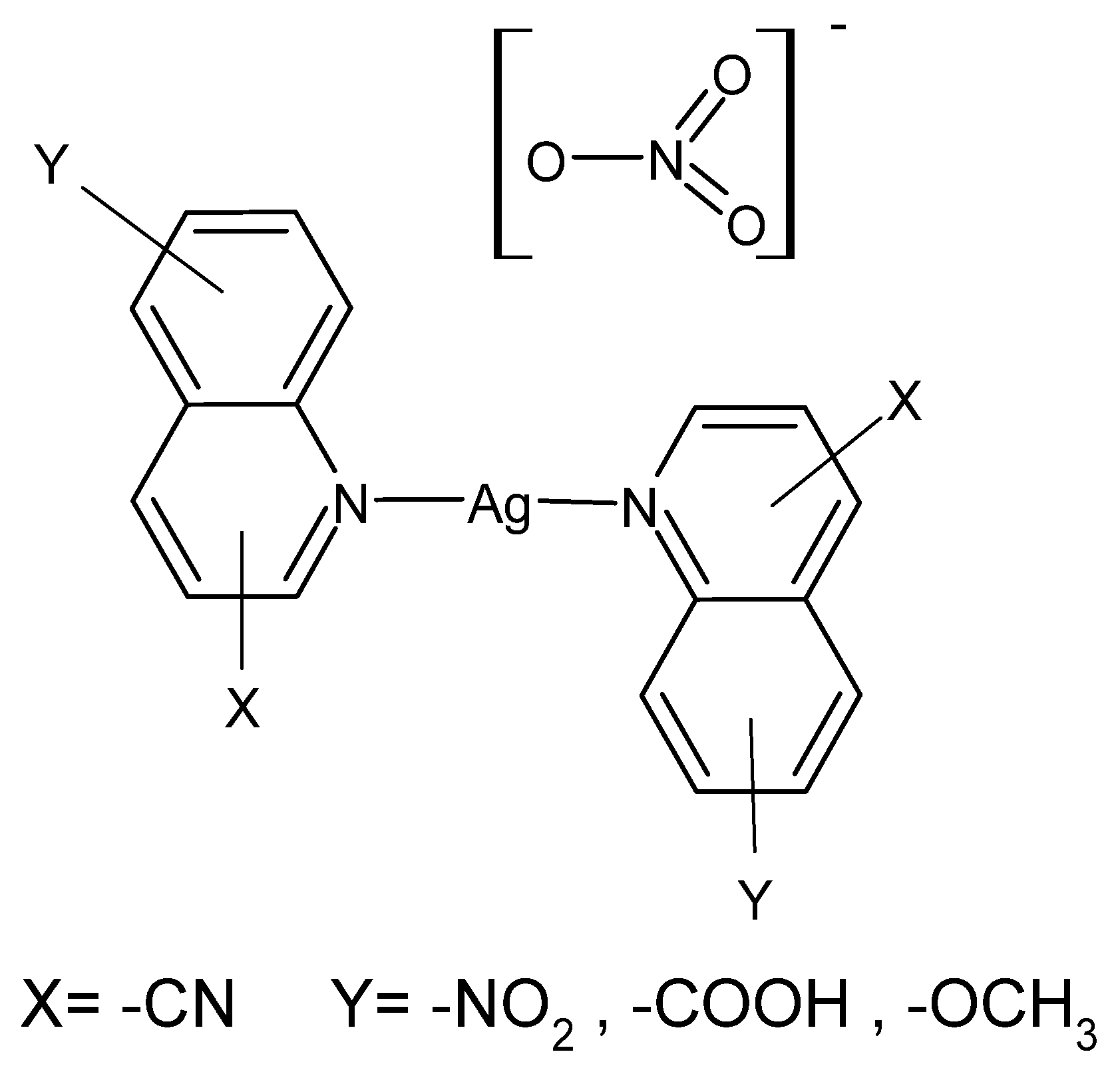

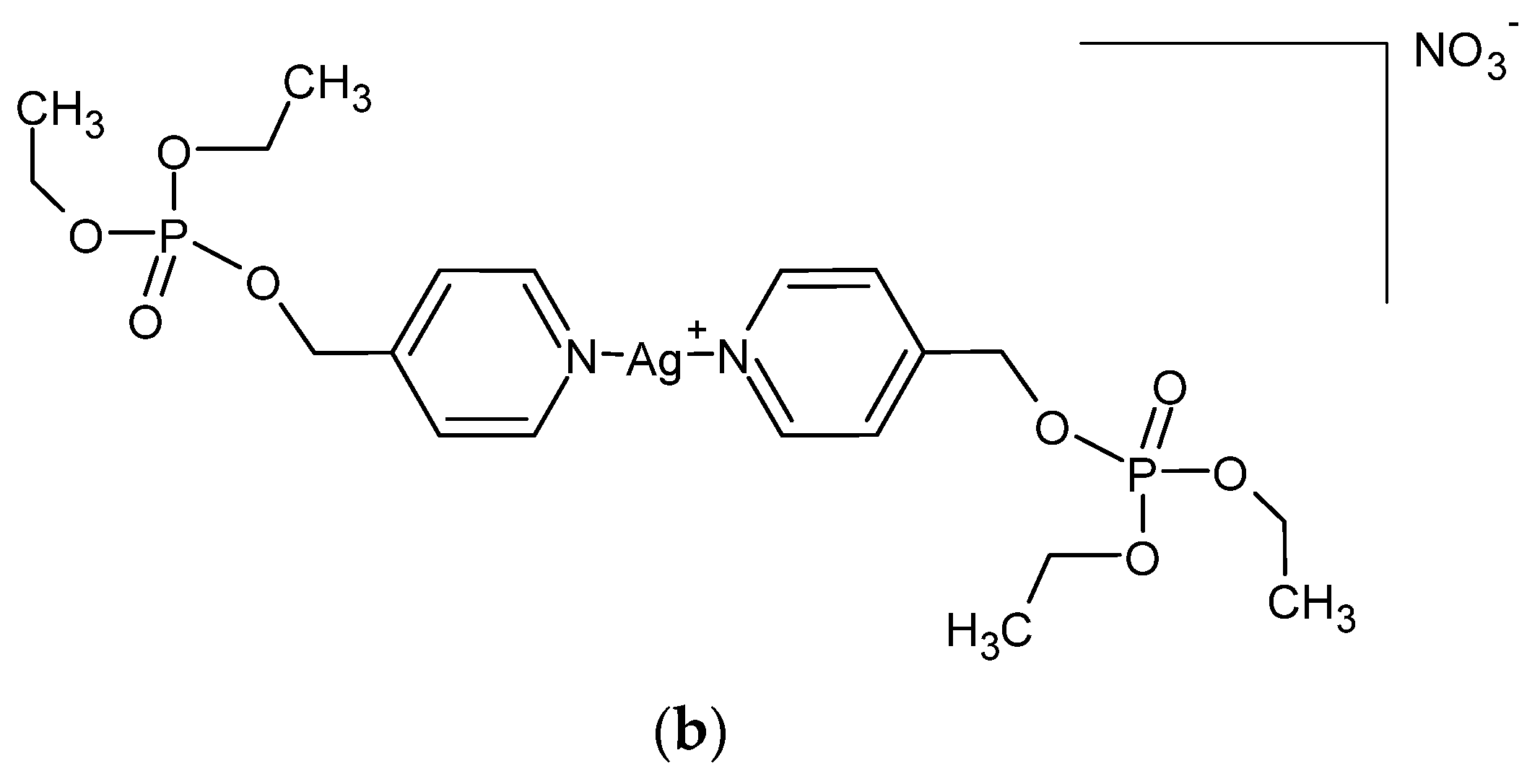
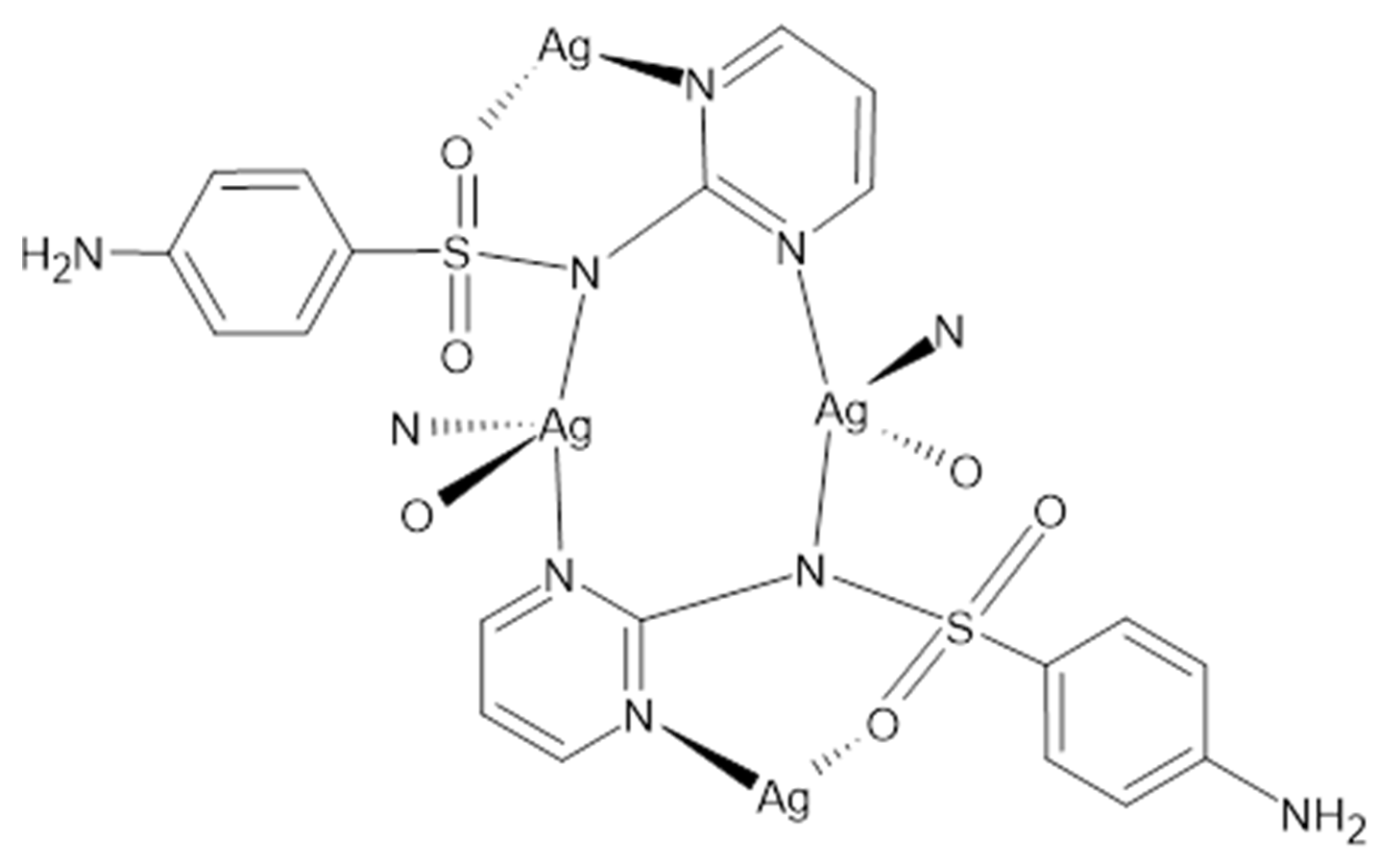
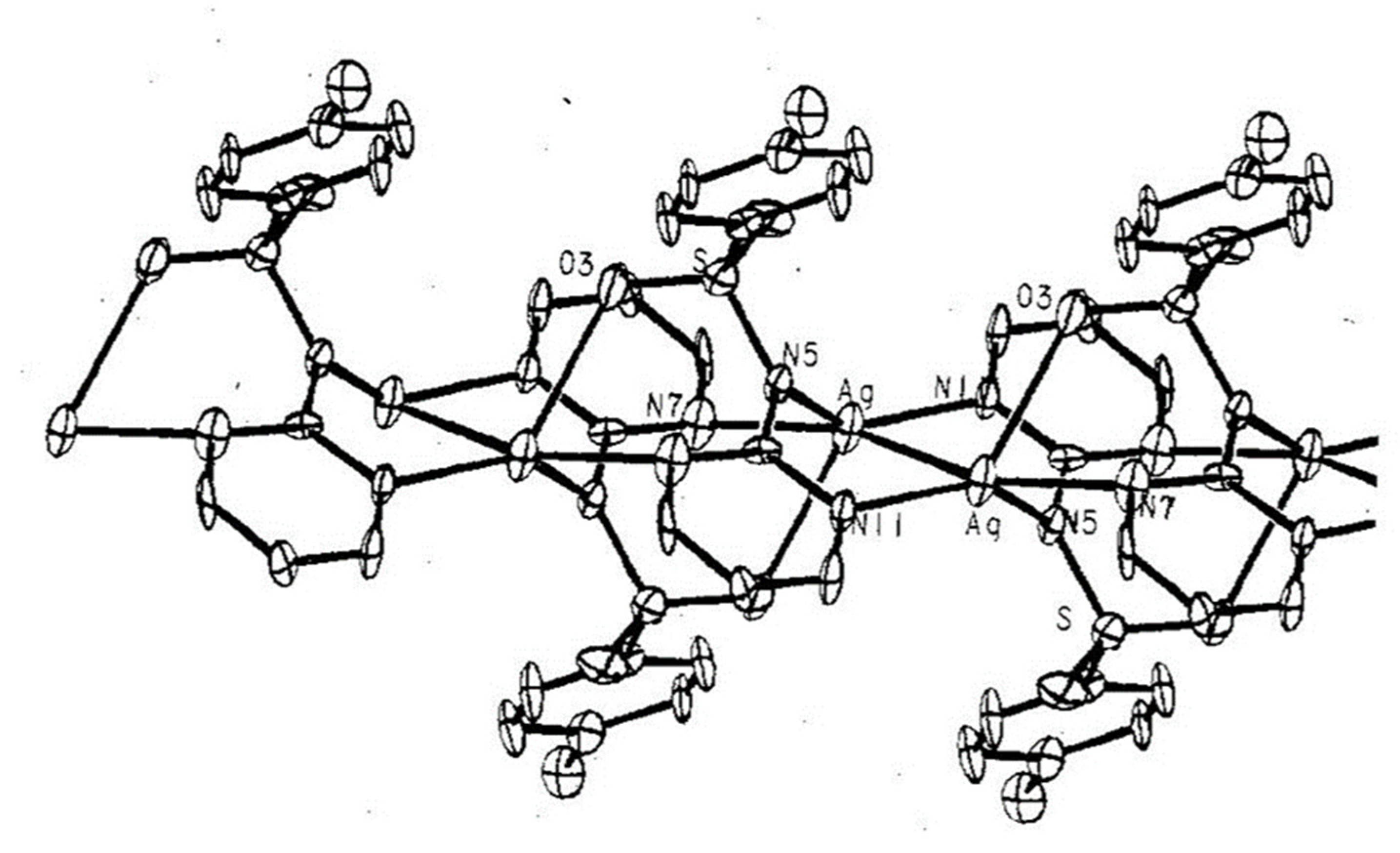
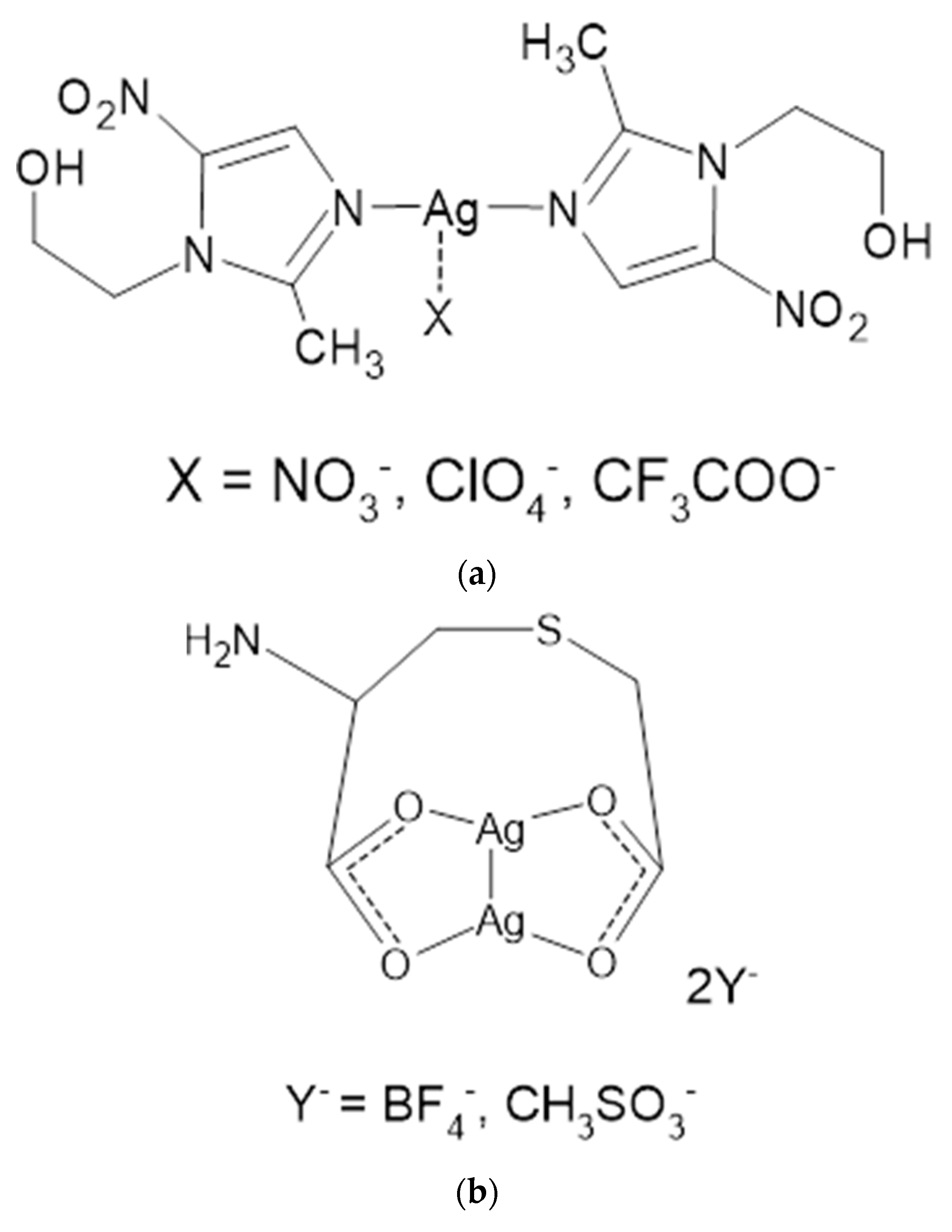

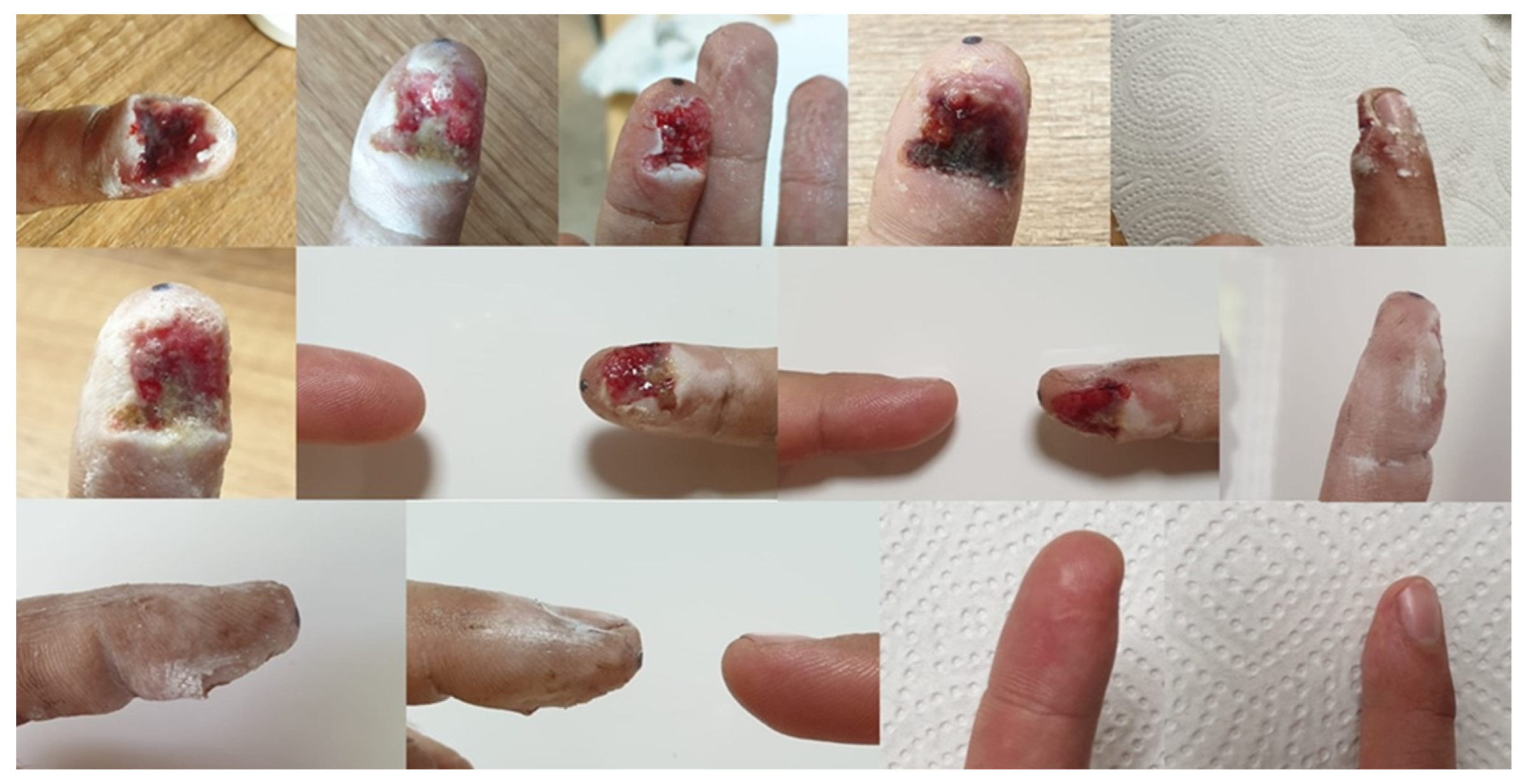
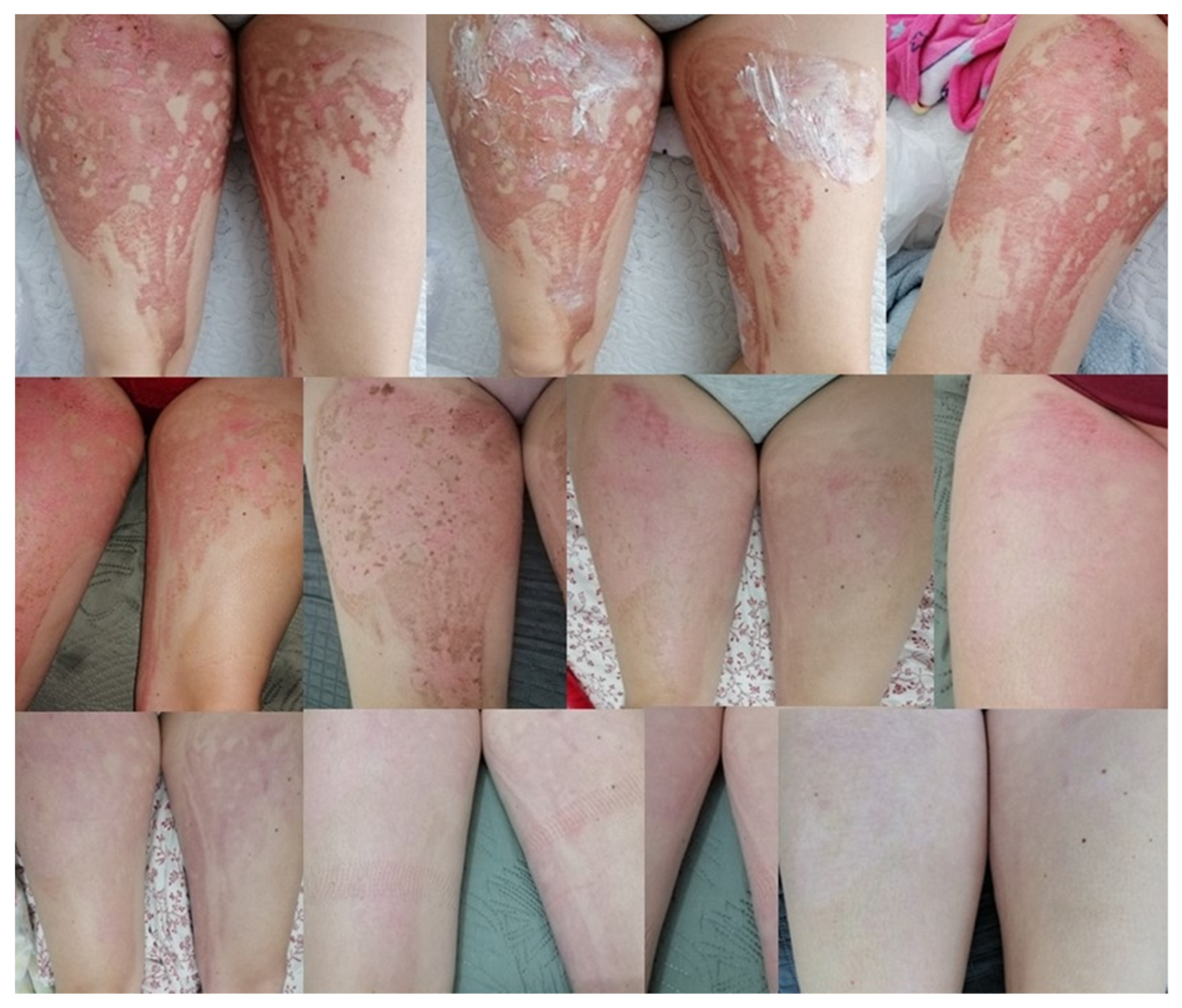
| Oxidation State | Electronic Configuration | Examples of Compounds |
|---|---|---|
| Ag 0 | d10s1 | rare; Ag(CO)3 in 10 K |
| Ag I | d10 | Ag2O, [Ag(OH)2]− (aq.), [Ag(H2O)4]+, AgF, AgCl, Ag+ salts e.g., AgNO3, Ag2SO4, Ag2S. Ag(CN)2− and other complexes |
| Ag II | d9 | AgF2, [Ag(C5H5N)2]+, AgSO4, Ag I and Ag III are in AgO (not Ag II) |
| Ag III | d8 | rare; [AgF4]−, [AgF6]3− |
| Silver (I) Salt | Chemical Formula | Solubility in Temp. 25 °C (g/100 g H2O) |
|---|---|---|
| Perchlorate | AgClO4 | 500.0 |
| Nitrate | AgNO3 | 257.0 |
| Fluoride | AgF | 100.0 |
| Acetate | CH3COOAg | 1.11 |
| Permanganate | AgMnO4 | 0.9 |
| Sulfate | Ag2SO4 | 0.83 |
| Nitrite | AgNO2 | 0.42 |
| Bromate | AgBrO3 | 0.16 |
| Salicylate | C6H4(OH)COOAg | 0.095 (in 23 °C) |
| Iodate | AgIO3 | 0.044 |
| Dichromate | Ag2Cr2O7 | 0.0083 (in 15 °C) |
| Chromate | Ag2CrO4 | 0.0035 |
| Carbonate | Ag2CO3 | 0.0033 |
| Citrinate | C6H8O7Ag3 | 0.00284 |
| Phosphate | Ag3PO4 | 0.000644 |
| Chloride | AgCl | 0.000193 |
| Stearate | CH3(CH2)16COOAg | 0.000065 |
| Sulphide | Ag2S | 0.000014 |
| Bromide | AgBr | 0.0000135 |
| Iodide | AgI | 0.00000026 |
| Cyanide | AgCN | 0.00000023 |
| Composition | Name—Dosage Form | Concentration | Application |
|---|---|---|---|
| Silver nitrate (I) with potassium nitrate | Lapis—pin | 97% | Tissue cauterization |
| Silver nitrate (I) | Mova Nitrat Pipette ®—eye drops | 10 mg/mL | Credé’s prophylaxis |
| Silver nitrate (I) | Component of pharmaceutical products | - | Pharmaceutical |
| Silver (I) sulfadiazine | Dermazin ®, Silvadene ®—creme | 10 mg/g | Burns of all degrees and sizes |
| Silver (I) sulfathiazole | Argosulfan ®—creme | 20 mg/g | Burns of all degrees and sizes |
| Finely divided silver (0) with protein or gelatin | Colargole, Argentum colloidale, Collargolum, Corgolum— component of pharmaceutical products | - | Pharmaceutical |
| Organic silver (I) complex with protein | Protargole, Argentum proteinicum, Protargolum, Prorgolum— component of pharmaceutical products | - | Pharmaceutical |
| Diacetyl Tannin Silver (I) Proteinate | Targezine, Targesinum, Argentum diacetylotannicum albuminatum— component of pharmaceutical products | - | Pharmaceutical |
| Name According to the Monograph in FP II | Polish Name | Synonyms FP II | Description (Original Wording) | Form and Properties (Original Wording) |
|---|---|---|---|---|
| Argentum colloidale | Srebro koloidalne | Corgol, Collargol | Argentum colloidale should contain not less than 70% Ag (atomic weight 107.9), the rest is: protein or gelatin and a small amount of silver chloride | Dark gray flakes with a metallic sheen, odorless, with a faint metallic taste. Colloidal silver slowly dissolves in the water. Argentum colloidale solution in 50 parts of water is opaque, and in reflected light—cloudy; becomes transparent when diluted with plenty of water, in reflected light, however, it is still cloudy. |
| Argentum gelatinosum | Żelatynian srebrowy | Argentum gelatosatum, Gelargin, Albargin, Gelatynian srebrowy | Argentum gelatinosum should contain no less than 14.6% and no more than 15% Ag (atomic weight 107.9) | Yellowish, fine, shimmering, odorless powder with a salty-insipid taste. Argentum gelatinosum is easily solublein water giving neutral or slightly acidic solutions. |
| Argentum nitricum | Azotan srebrowy | Argenti nitras, Argentum nitricum crystallisatum, Lapis infernalis, Lapis, Kamień piekielny | The preparation should contain no less than 99.6% AgNO3 | Colourless, odourless, transparent belts of the rhombic system. Silver nitrate dissolves in 0.5 part of water, in 15 parts of alcohol; very sparingly soluble in ether and glycerol. M.p. around 208 °C. Silver nitrate at 208 °C has the form of a yellowish liquid, which after solidification forms a white, crystalline mass; heated at a temperature higher than 208 °C, it gradually decomposes, releasing brown fumes. |
| Argentum nitricum cum Kalio nitrico | Azotan srebrowy z azotanem potasowym | Argenti nitras et Kalii nitras, Argentum nitricum fusum mitigatum, Lapis infernalis mitigatus | Silver nitrate with potassium nitrate should contain no less than 32.3% and no more than 33.5% AgNO3 (MW 169.9); the rest is potassium nitrate. | White or greyish-white, odourless, hard sticks with a smooth fracture, very soluble in water. |
| Argentum nitricum fusum | Topiony azotan srebrowy | Argenti nitras fusus | Fused silver nitrate should contain no less than 94.5% and no more than 95.5% AgNO3 (MW 169.9); the rest is potassium nitrate. | White or greyish, odorless sticks with a crystalline break. Fused silver nitrate dissolves very easily in water. |
| Argentum proteinicum | Proteinian srebrowy | Argentum proteinatum, Prorgol, Protargol | Silver proteinate should contain no less than 8% and no more than 8.4% Ag (atomic weight 107.91). | Yellow-brown, shiny flakes or yellow-brown, fine powder, almost odorless, with a first bland, then metallic taste. Silver proteinate is easily soluble in water, giving solutions of weakly alkaline reaction. |
| The Name of the Preparation by USL | Composition and Counterparts | Action | Application | Usage and Dosage (Doses in Grams) |
|---|---|---|---|---|
| Argentum colloidale subst. | Contains 70% silver (Argentum) giving colloidal solutions; Colloidal Silver; corgol; collargol | The drug has a bactericidal effect, and mainly stops the development of microorganisms in infectious states, improves the general condition of infections, causes a decrease in temperature. | Externally, it is used in inflammation of the mucous membranes (of bacterial origin), the conjunctival sac —in the form of instillations and ointments, and for flushing the urethra and bladder in the form of solutions. It is rarely used internally; in general infection and in infectious endocarditis, in typhoid fever. | It is used externally for instillation into the conjunctival sac in the form of 0.5–1% solutions, and in ointments 1–15%. For flushing the urethra and bladder, a 0.2–1% solution is used. Externally mainly in The form of rubs (Ung. Credé), intravenous injections and solutions. |
| Argentum nitricum subst. | Lapis infernalis, Argenti nitras, silver nitrate, hell stone | Internally, it has an astringent and antispasmodic effect. Externally: strong bactericide, astringent and caustic. | Externally, it is used to cauterize the diseased tissue. The drug is also used in inflammation of the mucous membranes (conjunctival sac, stomach, bladder). Internally, it is used in chronic diarrhea, peptic ulcer disease, atherosclerosis, in progressive paralysis (rare). | For instillation into the conjunctival sac, 0.25–0.5% solutions are used—after instillation, rinse with saline (0.9% Natrium chloratum aqueous solution). For flushing the bladder, solutions of 1:1000–1:3000 are used—after rinsing, rinse with saline. Internally: 0.01–0.1% solution 3 times a day a tablespoon or in pills (0.01–0.1) per day. |
| Argentum proteinicum subst. | Contains 8% organically bound silver (Argentum); Silver proteinate; prorgol; protargol | It has a bactericidal effect and anti-inflammatory, in inflammation of the mucous membranes of infectious origin. | It is used in inflammation of the mucous membranes, conjunctival sac—in the form of instillations and ointments, and for flushing the urethra and bladder in the form of solutions. Too much in ulcerations, in infectious inflammations of the nasal mucosa. Internally very rarely used in enteritis in children. | It is used externally for instillation into the conjunctival sac in the form of 0.5–1% solutions and in ointments 1–15%. For flushing the urethra and bladder—0.2–1%–2% solutions are used. Internally 0.1–0.3 per day. |
| Name According to the Monograph FP XII | Polish Name | Names in Other Languages (According to Ph.Eur.) | Route of Administration | Doses, Concentrations Typically Used |
|---|---|---|---|---|
| Argenti nitras | Azotan srebra | Silver nitrate; Argent (nitrate d’) | externally | For the skin 1.0–2.0% For flushing 0.05–0.1% Into the conjunctival sac 0.1–0.5% Newborns 1.0% 1 drop into the conjunctival sac For brushing the oral cavity 1.0–2.0% In dentistry 10.0–20.0% |
| Argentum colloidale ad usum externum | Srebro koloidalne do użytku zewnętrznego | Silver, colloidal, for external use; Argent colloïdal pour usage externe | externally | Solution 0.2–1.0% Ointment 1.0–15.0% |
Disclaimer/Publisher’s Note: The statements, opinions and data contained in all publications are solely those of the individual author(s) and contributor(s) and not of MDPI and/or the editor(s). MDPI and/or the editor(s) disclaim responsibility for any injury to people or property resulting from any ideas, methods, instructions or products referred to in the content. |
© 2023 by the authors. Licensee MDPI, Basel, Switzerland. This article is an open access article distributed under the terms and conditions of the Creative Commons Attribution (CC BY) license (https://creativecommons.org/licenses/by/4.0/).
Share and Cite
Żyro, D.; Sikora, J.; Szynkowska-Jóźwik, M.I.; Ochocki, J. Silver, Its Salts and Application in Medicine and Pharmacy. Int. J. Mol. Sci. 2023, 24, 15723. https://doi.org/10.3390/ijms242115723
Żyro D, Sikora J, Szynkowska-Jóźwik MI, Ochocki J. Silver, Its Salts and Application in Medicine and Pharmacy. International Journal of Molecular Sciences. 2023; 24(21):15723. https://doi.org/10.3390/ijms242115723
Chicago/Turabian StyleŻyro, Dominik, Joanna Sikora, Małgorzata Iwona Szynkowska-Jóźwik, and Justyn Ochocki. 2023. "Silver, Its Salts and Application in Medicine and Pharmacy" International Journal of Molecular Sciences 24, no. 21: 15723. https://doi.org/10.3390/ijms242115723
APA StyleŻyro, D., Sikora, J., Szynkowska-Jóźwik, M. I., & Ochocki, J. (2023). Silver, Its Salts and Application in Medicine and Pharmacy. International Journal of Molecular Sciences, 24(21), 15723. https://doi.org/10.3390/ijms242115723







